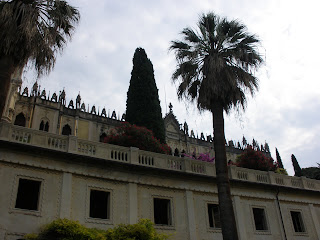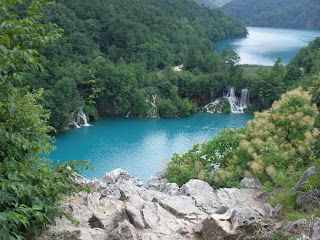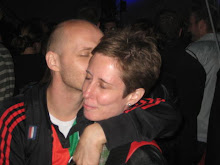Isola del Garda

This beautiful palazzo, on its own private island, is owned by the same family who operates the campsite we stayed at; and we had a perfect view of it sitting on "our" small morning beach. Seeing that NL sadly lost the World Cup final on Sunday 11/07, we required some distraction the following Monday morning so went on a guided tour offered to guests of the campsite :-)
The island has had a varied history and has been used for many different purposes over the years.
The first historical mention can be found in a decree by Charlemagne in the year 879 which documented the donation of the island to the monks of San Zenon of Verona. The island remained the property of the monks for an undetermined time, and around 1180 St Francis of Assisi visited many areas of northern Italy including Lake Garda. He apparently made a simple hermitage in the rocky part on the northern end of the small island. The island was continuously occupied by the monks, and in 1429 the old monastery was renewed and enlarged. From 1685 to 1697 it remained a convent for novices where the monks went into retreat.
In 1778 the by now outdated monastery was suppressed by Napoleon, who then acquired the right of property on the island. It later became the property of the state and in the following years had various owners. In 1860 it was dispossessed by the state and given to the army. The idea to build a fortress was quickly abandoned and it was decided to sell it at auction; the property was awarded to Baron Scotti who sold it to Duke Gaetano de Ferrari of Genoa and his wife, the Russian Archduchess, Maria Annenkoff.
Between 1880 and 1900 the new owners dedicated their time to planning the park, building containment walls, and importing fertile earth & exotic plants (including some of THE oldest, biggest and most gnarled olive trees I have ever seen!). The gardens are now surrounded by terraces with elaborately designed hedges and flowering bushes. Before the Duke’s death in 1893, the two of them together conceived the project of a palazzo to be built on the site of the old villa. The new builiding, in Neogothic-Venetian style, was constructed between 1890 and 1903, and was designed by the then reknowned architect Luigi Rovelli.
After the death of Maria, the island passed on to her daughter Anna Maria, wife of Prince Scipione Borghese of Rome. Anna Maria loved the island very much and made it her home until the end of her life.
In 1927, on the death of Anna Maria, the island passed down to her daughter Livia, married to Count Alessandro Cavazza of Bologna who kept it in an excellent state to leave it to his son Camillo, who in turn left it to his wife Charlotte and their seven children (the 4 brothers and 3 sisters who own Fornella Camping) - phew! Today the family continue to passionately look after the park and the palazzo where they actually still live.
As fortification half way through the 2 1/2 hour tour we had a break and were able to sample the olive oil that is also produced by this industrious family :-)
Alli xxx





























































